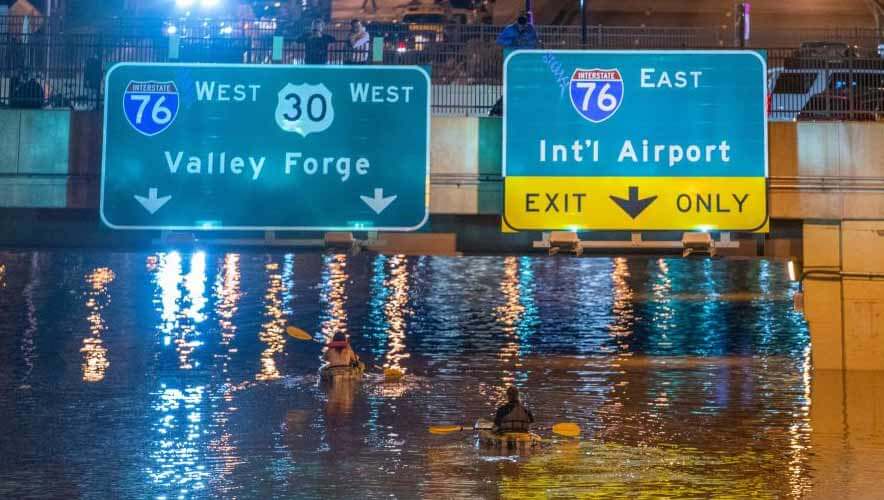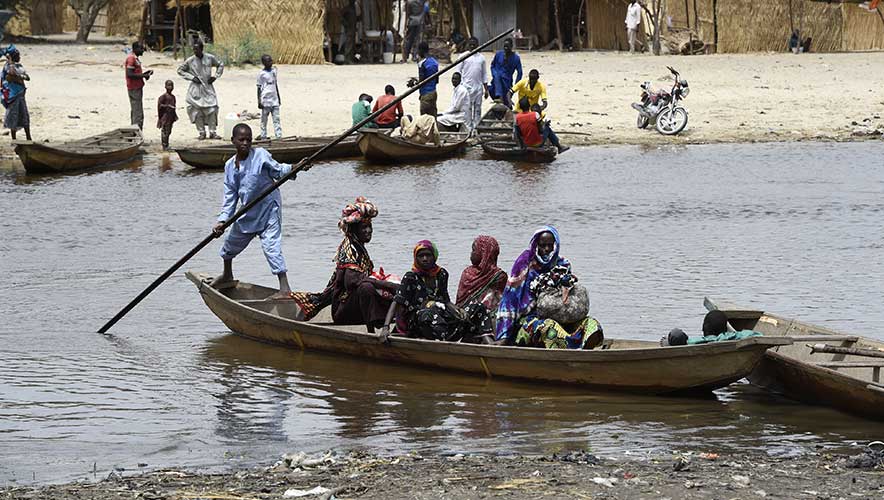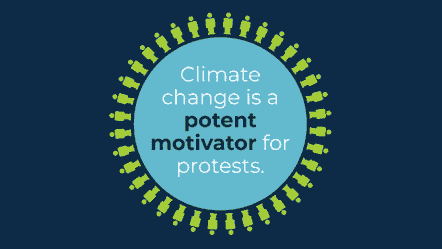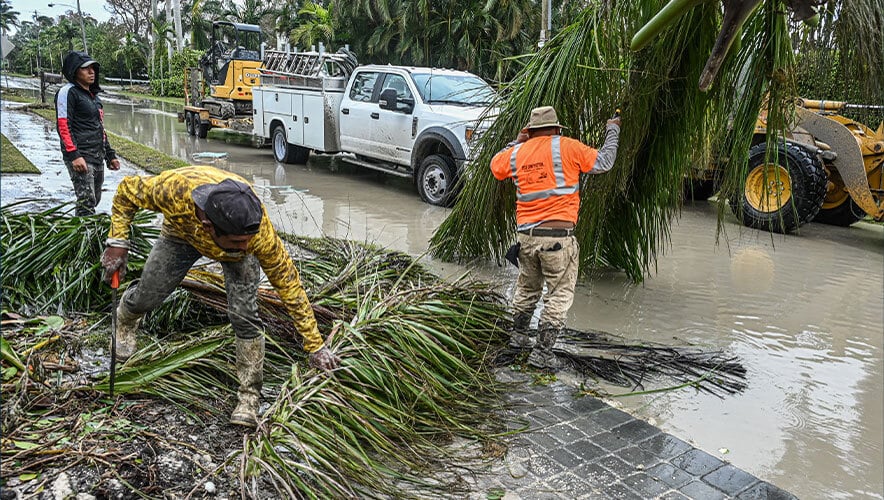The Missing Link in Business Continuity Planning: Accounting for the Impact of Climate Change
Climate-related events and ramifications account for the top five global risks for the next decade in the World Economic Forum’s 2023 Global Risks Report. Climate change also ranked among the top five concerns cited by the Institute of Risk Management in its 2022 list. Extreme weather events such as hurricanes and flooding are increasing in many regions of the world. While climate change is often characterized as a long-term problem, its potential to increase the near-term risks of high-impact, high-probability weather events is a concern for organizations.
Climate change is projected to increase the frequency and intensity of extreme weather events. Heat waves will be more severe, leading to droughts, and intense precipitation will lead to floods. Warming temperatures will increase the intensity of extratropical hurricanes. There is evidence that Category 4 and 5 hurricanes with sustained winds of 135 mph or higher could become more frequent.
The estimated losses due to climate change could be between $126 trillion and $616 trillion until the year 2100 given current commitments from organizations and governments, according to 2020 research published in Nature Communications. Losses from natural disasters worldwide in 2021 hit $280 billion, making it the fourth-costliest year since 2011, insurer Munich Re found. More than 50 major flood events caused $82 billion of economic losses globally in 2021.
In addition to the commercial liabilities associated with business disruptions, there are legal and corporate reporting implications. Rapidly developing climate related regulations can leave organizations open to legal action or fines, Chubb Institute found. According to the U.S. Securities Exchange Commission (SEC) the impacts of climate change on a company’s financial situation must be disclosed by listed organizations. Similar climate change disclosure rules are in place for organizations listed on exchanges in Australia, Denmark, South Africa, Sweden, and the United Kingdom. The UN’s Global Framework for Climate Risk Disclosure calls on organizations to analyze the impact of climate change and report on the implementation of mitigation measures.
Many organizations are experiencing the impacts from extreme weather events or expect to in the near future. Climate change could disrupt business models and destroy enterprise value that has taken decades to build. Recent severe storms, heat waves, and flooding events are just an early warning of what could come.
The Organizational Impact of Climate Change
Climate change can disrupt supply chains, cause financial losses, and damage facilities. This can have myriad effects on business operations and security plans.
Business Travel
A Category-3 hurricane on the U.S. East Coast can cause an interruption of approximately $32 billion to top-line corporate revenues, according to 2011 research from the Global Travel Business Association (GBTA). U.S. business travel losses from a storm of this magnitude include 514,000 cancelled trips and $606 million in spending due to hurricane related cancellations, GBTA estimated. In the decade since that initial research, storms have intensified—leading to even more travel ramifications.
Weather related flight cancellations and delays have increased over the past two decades in the United States and Europe. In 2021 severe winter weather forced the cancellation of more than 300 flights at both Chicago’s O’Hare airport and Dallas/Fort Worth airport, The Financial Times reported. Airlines canceled more than 3,500 flights across the United States due to Hurricane Ian in 2022 while airports in Florida were shut down. The share of cancelled flights in the United States increased from 35 percent in 2004 to 54 percent in 2019, according to The Financial Times. The number of delays in European airspace rose from 3.5 million in 2003 to 6.5 million in 2019.
Transportation Infrastructure
The U.S. Federal Highway Administration (FHWA) attributes 21 percent of all roadway crashes to inclement weather—affecting nearly 1,235,000 crashes each year. The FHWA estimates that 23 percent of non-recurrent delays on U.S. highways are related to snow, ice, and fog, resulting in an estimated 544 million vehicle-hours of delay every year. Trucking companies and commercial vehicle operators lose more than 32 billion vehicle hours annually due to severe weather-related congestion, costing trucking organizations anywhere from $2.2 to $3.5 billion dollars, the FHWA estimated. Without changes, this number is projected to increase substantially.
Projections show that bridges, tunnels, and airports will become vulnerable as sea level rises. In the United States, around 40,500 miles of navigable waterways in rivers facilitate transportation by ships and barges. There is a climatic shift to a systematic and a long-term increase in flood incidence and scale in Mississippi, Missouri, and Ohio, which have riverine transportation systems. Record water levels on the Mississippi River in 2019 disrupted the key transport network for exporting U.S. agricultural goods, causing losses valued at almost $1 billion, according to a 2022 report from the Environmental Defense Fund (EDF) and RTI International, Act Now or Pay Later: The Costs of Climate Inaction for Ports and Shipping.
In 1996, a record-breaking 24-hour rainstorm resulted in flash flooding in Chicago. There were extensive travel delays on highways and railroads, commuters were unable to reach Chicago for up to three days, and more than 300 freight trains were delayed or re-routed. These record-breaking weather-related events are becoming more common.
Additionally, road infrastructure along approximately 60,000 miles in U.S. coastal areas is vulnerable to sea level rise and storm surges, according to the U.S. Climate Resilience Toolkit.
A U.S. National Oceanic and Atmospheric Administration (NOAA) assessment in 2012 found that Hurricane Irene-related flooding resulted in more than $733 million in damages, including the damage to or complete loss of 2,400 roadways, 300 covered bridges, and six railroad tracks.
In 2021, Hurricane Ida struck the United States along the Gulf of Mexico, forcing a diversion of trucks—already in short supply across the country—for use in relief aid, The New York Times reported.
Airports
In addition to causing closures or delays, flooding may damage airport facilities, including runways. Thirteen of the 47 largest U.S. airports have at least one runway within 12 feet of sea level, making them particularly vulnerable to coastal storm surge and inundation.
Brookings Institute found that with just one foot of sea level rise, four significant U.S. airports will face significant flooding on more than 10 percent of their land. In New York, New Jersey, and Connecticut, many critical transportation infrastructure facilities (including Newark and La Guardia airports) lie within the range of current and projected 50-year coastal storm surges, according to 2017 numbers from the U.S. Environmental Protection Agency (EPA).
Ports and Canals
Larger storms coupled with sea level rise will increase the duration of port closures. An analysis of storm-related disruptions across 74 ports in 12 countries found that an additional meter in storm surge height or 10 meters per second in wind speed is associated with two days of average increase in the duration of disruption, according to the RTI-EDF report.
Hurricane damage to U.S. ports have averaged almost $430 million per year, the report found. In 2012, Hurricane Sandy caused the complete shutdown of the Port of New York and New Jersey for more than eight days.
Tropical storms in Asia-Pacific also have widespread ramifications for ports. In 2011, Cyclone Yasi cost the Port of Brisbane $52 million and 10 days of operations. Typhoon Haikui caused $10 million in damage to the Port of Shanghai in 2012. In 2019, Typhoon Lekima caused a loss of $65 million to the Port of Dalian and closed the Port of Wenzhou in China for 45 days, Insurance Journal reported.
There are 12 major ports in East Asia that are highly exposed to typhoon hazards. These ports have a combined annual throughput of more than 160 million TEUs (20-foot equivalent units—a measurement to determine cargo capacity)— which is around 20 percent of the global total. Almost 290 ports (14 percent of all ports) are at extremely high risk, with more than 30 percent of them located in Indonesia, Japan, the Philippines, and the United States.
The Port of Busan in South Korea, which is among the 10 most active ports in the world was inoperable for 91 days due Typhoon Maemi in 2003. Typhoon Maemi damaged 11 cranes and flooded the container yards, the RTI-EDF report said. A 10 percent increase in typhoon intensity can result in between 18 percent and 43 percent more downtime for Japanese ports, resulting in significant costs to the national economy, according to 2017 research from the University of Rhode Island.
Even ports in Europe that are currently considered well protected against high intensity storms—like in Rotterdam, Amsterdam, and Hamburg—are expected to need upgrades for their flooding defense systems to address from future sea level rise, according to the RTI-EDF report.
In South America, extreme rainfall in 2008 forced the closure of the Paranaguá Port, one of the most important ports in Brazil, resulting in losses of $350 million. More recently, landslides caused by heavy rainfall in November 2022 blocked road and rail access to the Paranaguá port, disrupting the flow of trucks headed to the coast, MarineLink reported.
The Panama Canal area experienced a rainfall deficit of more than 25 percent in 2019, the RTI-EDF report said. As a result of severe drought in the region, the Panama Canal Authorities set limits on traffic that cost global shipping companies between $230 million and $370 million.
The Domino Effect: Floods in Thailand
In the 2011 monsoon season, Tropical Storm Nock-ten unleashed waves of flooding across Thailand. The floods spread across multiple river basins to inundate 65 out of Thailand’s 76 provinces, damaging 7,700 square miles of farmland, displacing millions of people, and resulting in 815 deaths. The flooding in Thailand highlighted the vulnerabilities of production and direct exporting when prevailing just-in-time procurement models and management had not fully accounted for the potential damage from supply chain disruptions, according to an article in the International Journal of Disaster Risk Reduction.
“Today’s global supply chain has achieved cost reduction by reducing inventory, shortening transportation timelines, and streamlining production systems,” wrote the researchers, Masahiko Haraguchi and Upmanu Lall. “However, with lean and complex supply chains, there is much more susceptibility to systemic risk, a financial term used to describe a risk originating from one node of a financial network which then harms the entire financial market. This notion of risk is applicable to supply chains. While a more efficient production and transportation system is more capital intensive and cost efficient, in the event of a natural disaster, the entire system may suffer disruption and break down.”
The Thai floods showed that disasters in one country can significantly affect manufacturing industries in many countries. Direct losses from the floods were estimated at $15 billion to $20 billion, according to a 2013 report from the Center for Climate and Energy Solutions (C2ES), Weathering the Storm: Building Business Resilience to Climate Change. The floods affected about 10,000 factories, including 804 in just seven inundated industrial parks.
Of those factories affected by the floods, 56.7 percent were owned or operated by Japanese organizations, Haraguchi and Lall noted.
Honda operations were shut for six months, and its two production lines were beyond repair, according to a briefing from Just Auto. Its estimated production losses were more than $250 million, the C2ES report said. A shortage of parts forced Toyota to produce 30 percent fewer vehicles at its Japanese plants and postponed the launching of new models. HP estimated that more than half of its 7 percent revenue decline in the fourth quarter of 2011 was attributable to a shortage of hard disk drives caused by the flooding in Thailand. Construction firm Holcim was affected by severe flooding in both Thailand and eastern Australia in 2012, resulting in a loss of $15 million. With more than $46 billion in damages, the 2011 Thai floods were ranked by the World Bank as the fourth-costliest disaster at the time.
Mitigation Measures
“When risk management professionals hear that the Polar Vortex is collapsing, they aren’t simply worried about how cold it will get; they are focused on the impact to business operations,” wrote Ann Pickren for Continuity Central in 2019.
For security and business continuity professionals, mitigation measures vary broadly, depending on a company’s unique risk profile. Organizations could check location specific risks based on historical patterns as well as mid- to long-term weather forecasts, Pickren wrote. Companies should conduct a disaster vulnerability analysis before expanding company operations to a new location. Organizations can globally distribute manufacturing sites to ensure that they are able to shift supply of products among sites in the event of a catastrophe.
Multinational Spanish banking group Banco Bilbao Vizcaya Argentaria (BBVA) has a total of 128 business continuity plans implemented in 25 of the 32 countries in which it operates, the C2ES report noted. “These plans were put to the test during floods and power outages in Venezuela, La Niña triggered floods in Colombia and storms and tornados in Alabama,” the report said. “By implementing its business continuity measures, in each case BBVA was able to continue to render its critical services and comply with its obligations to society and various authorities.”
Security’s Role
Through a global security operations center (GSOC) or similar security management hub, chief security officers (CSOs) can assume emergency management functional responsibility for coordination with the municipal and police authorities, hospitals, electricity department, disaster management cells of business associations, and the fire brigade. The CSO could activate emergency response teams; conduct a quick damage assessment; assist in search, rescue, and emergency evacuations of employees; provide medical assistance; and incorporate security and safety measures during infrastructure restoration work.
The GSOC can be the technological hub for coordination between the company’s emergency management teams and federal and state government authorities. Alerts can be disseminated through various apps that can provide updated information on safety and security to employees. The GSOC can inform employees and vendors about areas that are likely to flood, assess damage to facilities from the video surveillance cameras, implement the measures which are mentioned in the emergency management standard operating procedures (SOPs), and provide updated information to the company’s communications director through the CSO.
The site infrastructure—which also includes the main server or data centers—can be destroyed during an earthquake, fire, flooding, or a hurricane. The chief information security officer (CISO) or CSO can have a data loss prevention strategy in place for employees. It’s crucial to have a combination of onsite and offsite backups of the organizational data which can be stored at geographically dispersed locations of the organization and on cloud infrastructure.
Assess Vulnerabilities
Organizations can conduct vulnerability assessments of facilities and operations in high-risk regions. A climate monitoring expert group could be established to observe local climate changes. For example, organizations operating in Southeast Asia can conduct geographical assessments to understand flooding during incessant rains.
Organizations could create an inclement weather policy for their employees. The policy will help organizations fulfill duty of care responsibilities.
Other measures can include the identification of critical dependencies, materials, and utilities. Market vulnerability analysis can be conducted to ensure that the supply chain is not disrupted.
Environmental Intelligence
Environmental intelligence uses the power of artificial intelligence to improve responsiveness to unpredictable weather conditions. The technology provides environmental data and forecasting capabilities to deliver greater insight into what weather is coming and how it might affect organizations. Organizations can mobilize facility and maintenance teams in advance to prevent damages to assets. Aviation operators are already leveraging environmental intelligence tools to assess weather risks and make necessary and agile decisions to protect personnel and maintain operations, IBM noted in a 2022 blog.
“In the U.S., for example, Tornado Alley is moving eastward due to climate change, disrupting lives that were historically safe from that type of weather event,” the blog explained. “During this new shifting tornado season, an aviation operator using reactive weather forecasting technology will be able to shut down operations quickly. But an operator using environmental intelligence can understand where the most severe tornados may form next. They may have facilities on high alert from the beginning of the season, build those facilities with future climate patterns in mind, or even avoid new investment in high-risk areas.”
Collaborate with Stakeholders
Management can work with other organizations or industry groups to identify best practices while industry associations could work with governments to craft environmentally friendly policies.
Natural disasters disrupt global supply chains for raw materials, plus equipment support and maintenance services. The CSO can engage with vendors in the critical function areas of banking, finance, logistics, fuel, telecommunications, and electricity to improve event response planning. CSOs could work with vendors in the following areas:
- Create a separate chapter on vendor management in the business continuity preparedness manual. The chapter can include measures to ensure deliveries of essential goods and to have a stockpile of inventory and supplies during and after natural disasters.
- Collaborate with vendors in analyzing levels of risk and vulnerabilities that could significantly disrupt the supply chain during a natural disaster.
- Have a diversified network of vendors. This will help the organization access products through alternative routes and modes of transportation.
- Identify other vendors across geographies with the same product.
- Assess vendors’ vulnerabilities according to low-, medium-, and high-risk categories.
- Organizations should have contracts with different telecommunications providers for redundancy and backups.
Research into the effects of climate change and related mitigation measures is readily available. Climate change scenarios and models can present a range of future impacts of concern to organizations. Organizations can incorporate data from the Intergovernmental Panel on Climate Change (IPCC), NOAA, and the U.S. Geological Survey into their analysis.
Organizations can also collaborate with universities or government agencies to better understand climate-related vulnerabilities and risks.
For instance, Bayer partnered with the Potsdam Institute for Climate Impact Research to develop scenarios of changes in hydrology, air temperature, sea level, and river flows that would affect the company and its markets over the next 10, 50, and 100 years, the C2ES report explained. Similarly, Australian mining company Rio Tinto commissioned the UK’s Hadley Centre for Climate Change to develop a range of scenarios for how changes in key climate variables over the next 25 to 50 years might affect regions where the company operates.
Such studies can form the basis for a variety of educational efforts such as briefings for senior managers, webinars for employees directly involved in planning for climate related risks, and guidance for specific business units, projects, or investments. Climate impact modeling tools can also be made available to managers for business continuity planning purposes.
The world economy may lose up to 18 percent of GDP from climate change if no action is taken, according to a 2021 estimate from Swiss Re Institute. Economies in Asia would be hardest hit, with China at risk of losing nearly 24 percent of its GDP in a severe scenario, while the United States stands to lose close to 10 percent, and the European Union almost 11 percent. Organizations should learn and adapt in the long term and thrive in a world beset by the unpredictability of a changing climate.
Mangesh Sawant is the CEO and Managing Partner at Quantico Consulting. Sawant has a master’s degree in international affairs from Columbia University, where he concentrated in international security policy. Sawant has more than 20 years of experience in homeland security, global security, geopolitical risk analysis, military studies, and developing case studies and lessons learned. His articles have been published in Small Wars Journal, The National Interest, E-International Relations, Indian Defense Review, Modern Diplomacy, Eurasia Review, Over The Horizon Journal, Geopolitical Monitor, Security Management (ASIS), Internationale Politik, CISOMAG, The Geopolitics, The Diplomatist, and Journal of Indo-Pacific Affairs.












